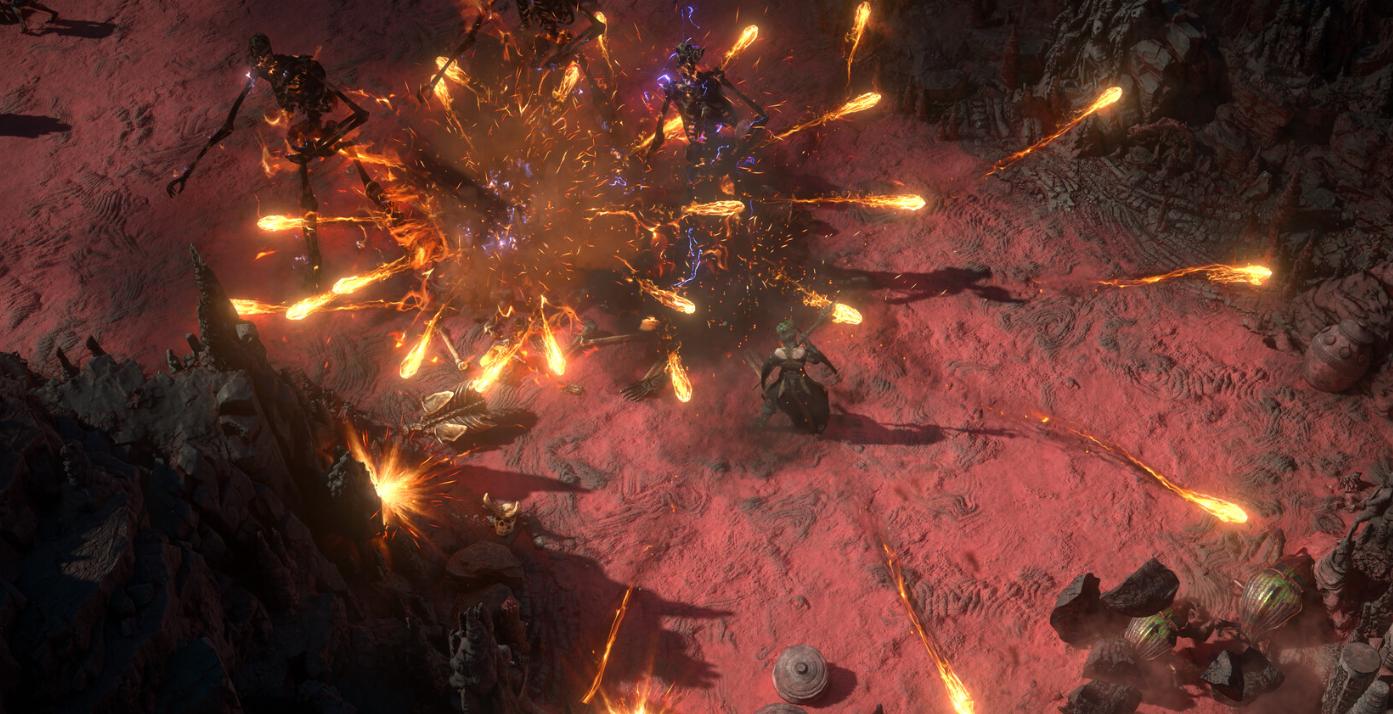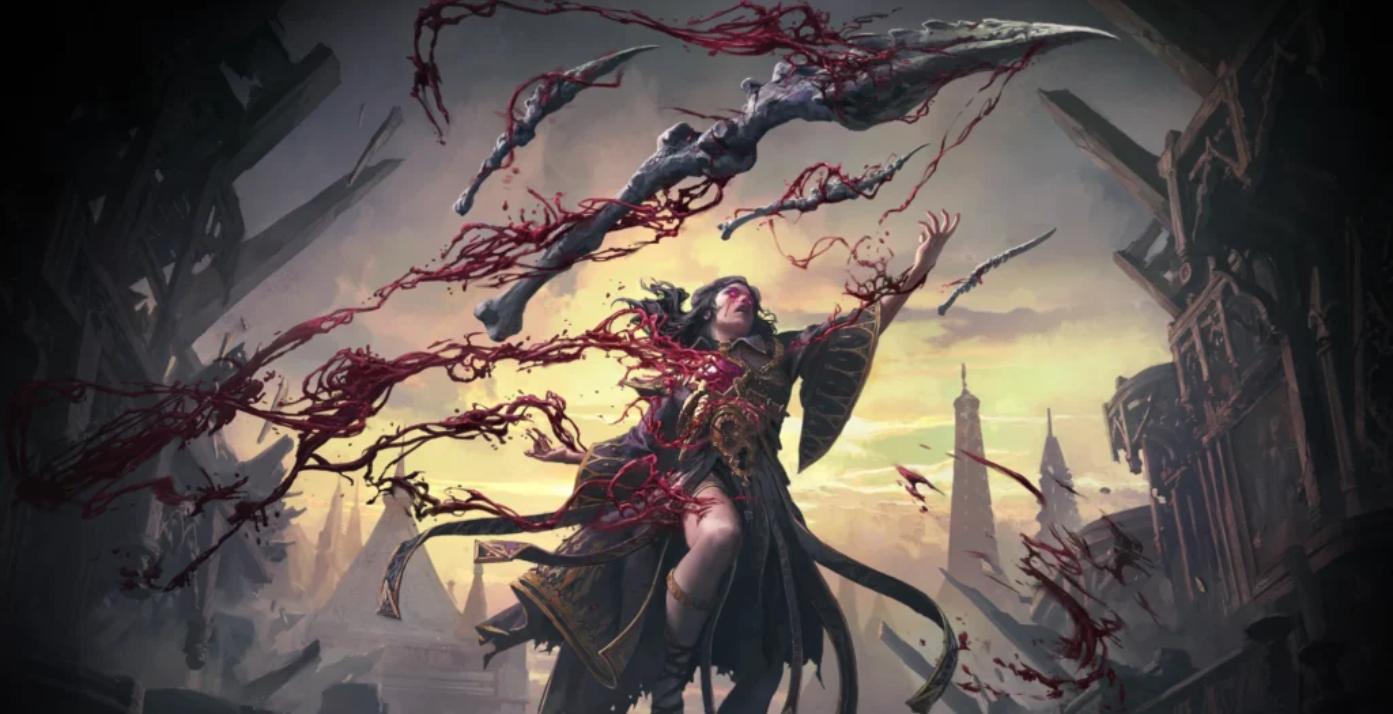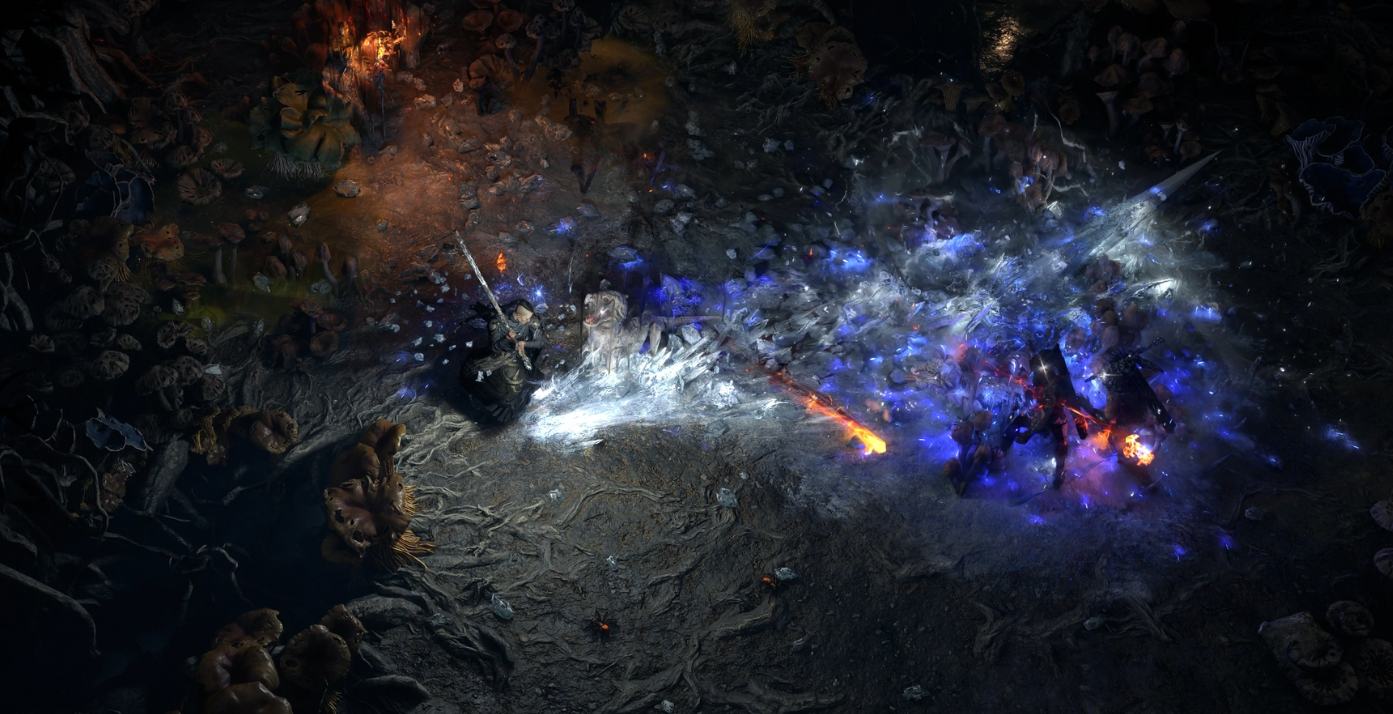Playing the demos months apart meant that I had to relearn the systems each time. And each time I learned again, there were more options to help ease me into the game as someone who doesn’t have a long ARPG track record. But intimidation didn’t sink in even with a passive skill tree that offers even more combinations than the original.
POE2 is best discussed in two parts. The first concerns the story, art, and characters, which together create a diverse and beautiful world. Yes, POE2 is beautiful. It’s macabre and bloody and features grotesque body horror that unites and amazes.
In this sequel, Wraeclast has been free from any sources of Corruption for 20 years. Only the Count of Ogham, tempted by promises of power, intends to harness it once more and throw the realm into Corruption. The dead are rising, monsters are mutating, and madness is spreading from this new Seed of Corruption. As you rush to stop the spreading danger, you uncover lost civilizations, with each act themed toward a specific people.
While the full game’s launch will feature six acts, the POE2 early access features the first three and totals about 25 hours before you can enter the Cruel difficulty, which acts like a New Game+ of sorts. In Act One, the dark, primordial forests of Ogham are where you spend your time, seeking out the Count and watching how the Corruption he’s unleashed and his violence have torn apart the land. Steeped in a European gothic fantasy style, the area’s maps are expansive and absolute sights to behold.
Path of Exile 2 is just plain beautiful to look at.

A manor is not a simple manor; it’s a weaving maze of staircases and halls with holes in the floor overlooking a pit where the Count sits on a throne, with the raised dead around him. POE2’s top-down perspective isn’t just used as a function of genre mechanics. Instead, this perspective is used to enhance the environmental art architecture, always focusing on making sure the skill animations have the space to shine.
The Count’s Manor isn’t the only time we see such detailed and layered environments. The ability to see each subsequent level as you descend to find the boss is gorgeously captured and ultimately builds tension as you get closer. This section of the game captures the traditional expectations for dark fantasy, the way gothic architecture inspires it.
Act Two is a whole different beast. As you meet the Maraketh, you enter the crimson sands, blackened wastelands, and salt flats of North African and Indian-inspired cultures. Boarding a nomadic caravan, you move across the ruins of old civilizations that still hold memories of a glorious past in the Vastiri Desert.
On the Caravan itself, the massive amount of detail put into every single pillow, carpet, blanket, and cloth is more intricate than anything I’ve seen all year. Even from your bird’s eye view, you can see how much attention Grinding Gear Games has put into even the smallest elements of the game’s environments. Every single section of the environment, every creature, and every boss is steeped in a personality that is leaps and bounds above any expectation.
The most astonishing amount of detail could also be seen in the most easily dismissed places, like the sand. When you first meet the Maraketh at the start of the act, you’re greeted by a red sand desert. With small flecks of gray and white, the sand becomes almost luminescent in how it captures the light. It’s stunning. Not to mention that fans of Dune will notice elements that fit that aesthetic. However, even when you can see inspiration in visuals, POE2 never once feels stale or like something we’ve seen before.
Act Three is probably my favorite area of POE2 as we head to the jungle ruins of Utzaal, an ancient Vaal city. Deeply rooted in Mesoamerican mythology, the vibrant jades and reds among the jungle are a sight to behold. Additionally, the unique creature designs for the environment make each area feel fresh, and in this case, introducing intricate stone creatures is a fascinating departure.
Creativity is at the core of POE2 – from the art style to how you build your character.

With the first three acts, POE2 early access is a bold take on act progression that thrusts its players into new areas with entirely different creatures that force them to adapt. More importantly, it shows the art teams’ depth in tackling unique civilizations and creating them as distinctive worlds to explore. It begs the player to keep coming back, keep uncovering every inch of the map, come back to boss battles they couldn’t beat the first time, and learn more about the world they’re exploring.
In addition to the beauty of the environments, POE2 features fully voiced characters. Their designs are interesting as you learn more about them and their connections to the world. Their character designs have depth in their interactions and how they look, with no two interactive NPCs looking the same. This helps the game’s story start to match the depth of its art and animations. The dedication to detail is also captured in the different available armor sets that evolve over time to fit the new locations.
But it’s not just the environment. The character animations, armor, item designs, and creatures are all visually distinctive from others in the genre. The main element of uniqueness comes from the fact that despite the game’s investment in darkness, none of its artistic elements feel muddied. Instead, thoughtful lighting and a dedication to developing unsettling textures clearly capture the difference between even the smallest detail on display.
With 50 bosses and 400 monster types available in Early Access, the art team’s dedication to creating horrific and terrifying worlds and enemies that offer grotesque beauty has been evident from the very first time I played.
Path of Exile 2’s lush environments are just the tip of the game’s creativity. The real creative investment comes from Grinding Gear Games’ investment in their core pillar: Player Power. With even more passive skill paths to explore and combine to suit your playstyle and tackle personal challenges, the game doesn’t forget about the hardcore player audience that made Path of Exile last for over a decade.
Instead, the onboarding and detailed tutorialization is done with consideration and care. As you acquire new skill gems that grant you abilities, equipping yourself with the skills you want to engrave can be difficult. Are you looking to build pure damage? Are you playing co-op and need to think about crowd control and support skills? Well, to start your playthrough, each time you choose to engrave a new Skill Gem, you’ll hear a voiceover read the skill details.
It’s a small guardrail that you internalize as you read new skills and make your choices. When it eventually falls off, you’ve already started to be more patient in picking and reading through skills. This helps impatient players like me understand the choices I’m making and how the skills work, which is also helped with small video animations.
Support Gems, Skill Gems, Passive Abilities, and weapon choices unite beautifully.
Your build takes shape as you combine the Active Skills you get from uncut Skill Gems. You acquire them as you kill enemies with your passive abilities. Once you understand the process of trying to find synergetic damage-focused Active and Passive Skills, the next building element is your Support Gems.
Support Gems are used to alter existing abilities and are tied to the abilities themselves; only quipped to a weapon when the skill is in use is granted by the weapon you’re wielding. Balancing the Skills Gems you choose against the skills offered by weaponry is also a place I had to explore. The only issue where the weight of POE2’s systems gets a little hard to understand is how different Support Gems specifically affect DPS and elemental effects. While there are some tooltips, the granularity that you need to understand isn’t always right at your fingertips. It’s the one learning curve you need to understand.
Playing as the Witch, I often defaulted to a Rattling Sceptre, which grants Skeletal Minions without using Spirit to summon them. However, since the Sceptre grants the Skeletal Minion skill, I didn’t need to take up one of my sockets by adding the same ability. Figuring out how to balance that was where I had to keep temperature checking myself and focus on when more minions helped my co-op runs and when my focus should be on auras.
That said, with built-in recommendations (which can be toggled if you wish), you can get started slotting Support Gems in suggested places until you are comfortable experimenting. This is yet another key example of the increased and incredibly thoughtful tutorialization you find in Path of Exile 2, which isn’t just a game for hardcore fans. However, they do have their path to walk if they’d like to. Then, of course, you factor in the new addition of charms that use flask charges to defend you from specific skills and elements automatically, and we can see even more customization on display.
The exciting combat choice that POE2 has, though, is allowing you even more player agency with your build by allowing you to move from weapon to weapon based on what Skill you activate instead of forcing you to swap right away to get access to the skills. The only time this was an issue was when there was a small hiccup with the game reading the scepters and the slots they were in, which wouldn’t register the full amount of my Spirit pool, which was necessary to maximize the minions that I was able to summon.
As you increase your Spirit pool, increase the number of minions you have summoned at any given time, and get the Blasphemy skill, the class becomes extremely powerful. However, in the early game until about mid-Act Two, the minion damages and is limited to the point of almost not mattering too much.
Path of Exile 2 offers complex combat from mobs to boss battles.

One interesting element in POE2 is that Health and Mana go hand in hand with combat. With only one flask slot for each that can be upgraded with new traits, refills require you to walk over a waypoint or checkpoint or fill them from the well in town. Otherwise, you will refill your charges and increase your Health reserve as you defeat enemies.
This means that additional phases are central to most major boss fights. Learning to utilize them effectively is key to making it through some of the bosses you experience, which get harder and harder as you progress through the story—as they should. This shows a level of balance in fight development that understands your needs as a player and always puts the way to progress at your fingertips without ever getting too guided or easy.
POE2’s difficulty is a fascinating creature all on its own. Some bosses get easier as you get better at building (or paying gold to rebuild) your character. Then, their element type switches, or you enter an area that decreases your resistance to certain elements, and you’re back at it, collecting items to help you succeed. It’s exciting to consistently adapt to new challenges and learn how to tackle tasks one at a time.
For Early Access, Path of Exile 2 is extremely polished and in a state that is beyond exciting, especially as a new player to the franchise. In fact, if you’re reading this, the key takeaway I need you to leave this review with is that POE2 is endlessly approachable. The concerted effort that Grinding Gear Games has put into creating something that any player can walk into, learn, and fall in love with, regardless of how much time they’ve spent playing the original game or playing ARPGs altogether.
Despite not having a background in POE, I never felt like I didn’t know what was happening or that I was missing out on building a character that works. Whether it was the voice-over explanations or the recommendations on using my support gems, the training wheels helped me become comfortable. And then, I took them off.
That said, I should note that I didn’t spend time with the game using the mouse and keyboard UI. While you can switch between click and WASD movement controls, you have to log out to switch from controller to full keyboard controls.
For Early Access, POE2 is thriving and ready for new players and veterans to jump in.

While you can still use your mouse and type in chat, the core functions of the game are locked to the scheme you launch with. You can change it by logging out and logging back in, but it can be slightly frustrating. Additionally, the HUD and menu system are different based on what controls you use, with the simplified controller inputs making it extremely easy to understand and never feel like you’re missing any options.
POE2 early access also launches with six classes: The Warrior, The Sorceress, The Witch, The Mercenary, The Ranger, and The Monk. With 12 total coming into the game when it’s fully launched, the diversity of playstyle is exciting, to say the least. The most drastic difference comes from Mercenary, a class that quite literally plays like a top-down shooter.
The Passive skill tree also allows you to blend different class weapons to explore combinations that make for some pretty powerful builds and creative play with its new Dual-Specialization Tree. I took advantage of that by mixing the Sorceress’ fire Skills with the Witch, while the colleague I played co-op with experimented with the Ranger and the Mercenary.
Ultimately, Path of Exile 2 may only be in early access, but it has far surpassed many games I’ve played this year. I mean this both from single-player and co-op play. It was easy to let hours pass and never once worry. While I still have yet to fully explore the Ascendancy classes, knowing that the character you build across each League can always be significantly more than you start with, depending on what you want, is a level of freedom that is refreshing.
While freedom and creativity have been core to Grinding Gear Games’ development philosophy for the title, the first game’s freedom was overwhelming. But with POE2, that barrier has been eroded. Jump in and play. Learn what you like, what you don’t like, and what works.
POE2 Early Access offers detailed and deep systems for hardcore fans to burn through and explore to reach the endgame or perfect builds. But for new players, the ability to choose how much they engage with the systems until they feel comfortable creates a rewarding experience.
Path of Exile 2‘s difficulty, combat, art, and map designs keep pulling you in. No matter how many times you die or how many times you have to adjust your build, you just keep coming right back. This is a game that is firing on absolutely all cylinders and shows no signs of slowing down.
Path of Exile 2 releases in early access on December 6, 2024.


